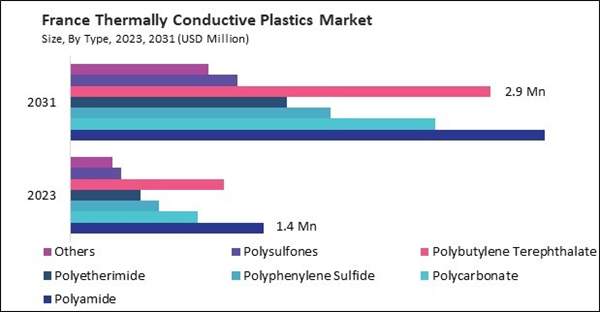As a high-performance engineering plastic, PPS is widely utilized in applications requiring effective heat dissipation, such as automotive under-the-hood components, electrical connectors, and industrial machinery. Its ability to withstand high temperatures without sacrificing its structural integrity makes it an ideal choice for demanding environments. Hence, in UK, 238.0 tonnes of PPS are expected to be utilized by the year 2031.
The Germany market dominated the Europe Thermally Conductive Plastics Market by Country in 2023, and is forecast to continue being a dominant market till 2031; thereby, achieving a market value of $22.72 millions by 2031. The UK market is experiencing a CAGR of 12% during (2024 - 2031). Additionally, The France market would exhibit a CAGR of 13.9% during (2024 - 2031).
With the rise of electric vehicles (E.V.s) and hybrid vehicles, thermally conductive plastics are increasingly used in battery packs to manage heat generated during charging and discharging cycles. These materials help dissipate heat away from battery cells, ensuring optimal performance and extending battery lifespan. In electric and hybrid vehicles, thermally conductive plastics are employed in motor housings and powertrain components to enhance thermal management and reduce weight. Manufacturers can improve vehicle efficiency and range by replacing metal enclosures with lightweight plastic alternatives.
Moreover, in aerospace applications, thermally conductive plastics are used in avionics enclosures, radar systems, and electronic control units to manage heat generated by onboard electronics. These materials help maintain stable operating temperatures in aircraft components, ensuring optimal performance and reliability. Thermally conductive plastics are used in aerospace LED lighting systems for cabin lighting, cockpit displays, and exterior lighting. These materials help dissipate heat away from high-power LEDs, ensuring long-term performance and durability in demanding aerospace environments.
Aerospace manufacturers increasingly seek lightweight materials to improve fuel efficiency and reduce emissions. Thermally conductive plastics, with their lightweight properties and ability to dissipate heat efficiently, are gaining traction in aerospace applications. The rising aerospace sector in the U.K. could drive demand for thermally conductive plastics as they are utilized in aircraft components such as avionics, LED lighting systems, and thermal management solutions for electronics.
According to the International Trade Administration (ITA), in 2022, U.K. civil aerospace turnover totaled approximately $34.5 billion. The United Kingdom space industry generated an estimated $22 billion in revenue in 2021, of which $9.5 billion was allocated for exports. Furthermore, by 2030, the impact of drones could increase the U.K.’s GDP by $53 billion. In conclusion, the growing aerospace industry and rising medical device sector in the region drive the market’s growth.
List of Key Companies Profiled
- Celanese Corporation
- SABIC (Saudi Arabian Oil Company)
- BASF SE
- Koninklijke DSM N.V.
- DuPont de Nemours, Inc.
- Lanxess AG
- Ensinger GmbH
- Toray Industries, Inc.
- Kaneka Corporation
- Covestro AG
Market Report Segmentation
By Type (Volume, Tonnes, USD Million, 2020-2031)- Polyamide
- Polycarbonate
- Polyphenylene Sulfide
- Polyetherimide
- Polybutylene Terephthalate
- Polysulfones
- Others
- Electrical & Electronics
- Automotive
- Industrial
- Aerospace
- Healthcare & Pharma
- Telecommunications
- Others
- Germany
- UK
- France
- Russia
- Spain
- Italy
- Rest of Europe
Table of Contents
Companies Mentioned
- Celanese Corporation
- SABIC (Saudi Arabian Oil Company)
- BASF SE
- Koninklijke DSM N.V.
- DuPont de Nemours, Inc.
- Lanxess AG
- Ensinger GmbH
- Toray Industries, Inc.
- Kaneka Corporation
- Covestro AG
Methodology

LOADING...









